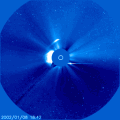|
back to spaceweather.com In early January, 2002, periodic comet 96P/Machholz put on a dazzling show as it swung by the Sun. On Jan. 8th, the comet was only 0.12 AU from our star -- even closer to the Sun than Mercury. During the fiery encounter sunlight warmed and melted part of the comet's icy nucleus; dusty vapors formed a long tail.
A remarkable scene, pictured above, unfolded on January 8th when a coronal mass ejection (CME) billowed away from the Sun just as comet 96P/Machholz reached perihelion. Although the CME appears to envelop the comet, it did not. Unlike many Sun-approaching comets, notably the "Kreutz sungrazers," 96P/Machholz survived its fiery experience and will return again in 2007. [SOHO also saw the comet in Oct. 1996] [3D orbit] |
